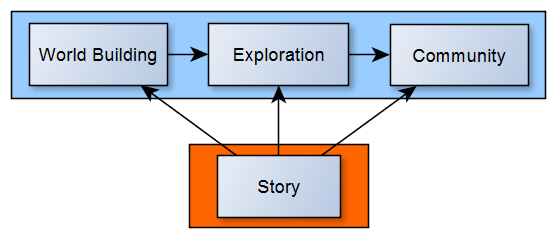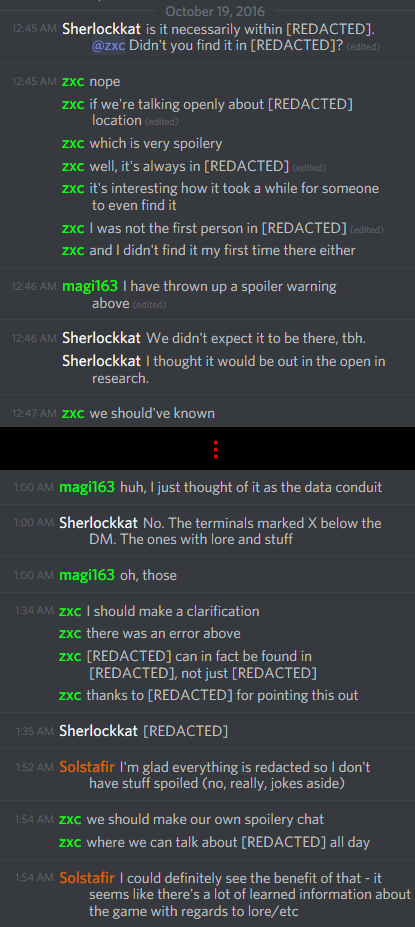There’s been very little discussion of Cogmind’s story here on the blog, which belies its informative role and importance throughout the alpha development process. In fact, following the mediocre stock sci-fi back story given to the 7DRL, on rebooting the project in 2013 the very first stretch of Cogmind development was actually devoted solely to fleshing out a unique story in great detail. Everything afterward would serve to support that narrative in one way or another.
Now that said part of the game world has taken shape and nears completion, it’s time to venture into new territory and discuss the whys and hows of integrating story elements into a genre traditionally light on story. This is the first in a three-part series:
- Part 1: Value
- Part 2: Characteristics
- Part 3: Methods
Note that this series is specifically about static narratives in procedurally generated worlds, and not generating the stories themselves! There’s quite a distinction between the two :)
(As usual I’ll be avoiding spoilers, although in this case it’ll mean fewer concrete examples until we get into Part 3.)
Why?
Naturally the first question here is why would we want to include a story at all? Roguelikes are not strict RPGs, and rarely put much effort into storytelling. In fact, there is even the danger of story ruining/interfering with what makes roguelikes great in the first place (a point we’ll touch on several times).
However, I’d argue that when used carefully there are quite a few ways in which story elements can enhance the roguelike experience, making them a potentially valuable addition. Let’s look at some of the benefits, which double as goals when designing a new roguelike.
World Building
Theme and setting define a roguelike’s starting point when it comes to source material, but crafting a story on top of it all (ideally with multiple plot lines) takes it to the next level. A story requires that actors have motives and goals, and the whole world feels much more alive when for the purposes of storytelling actors have goals other than “approach and kill player.” Certainly mechanics and basic content like actor/object descriptions can go a long way towards reflecting the nature and state of the world, but a full-on plot reinforces it all in the strongest way possible: through action.
Seeing the game’s lore in action really brings it to life, giving it added meaning beyond the words. From the beginning this approach has been important for Cogmind in particular because it strengthens the immersion, a focus of the whole player experience I’ve been going for. And on the development side that same desire to bring everything to life drives development to dig deeper. As the game world expands I’ve often asked myself “wouldn’t it be neat if the player could actually visit that place? Or meet so-and-so?” And then suddenly there they are, being written into the game :D. As a result the world has gotten increasingly dense over time, with each new piece reinforcing one or more others.
Meaning & Purpose
Roguelikes infused with story elements also gain additional layers of meaning on top of whatever might happen in the world, contributing to a more “epic feel”--the world is definitely bigger than the player character, who can have a greater purpose beyond being a “murderhobo.” With the 7DRL version a short back story merely provided the premise, good enough for a straightforward dungeon crawl, while I can’t imagine the Cogmind of today without its deep and engaging story. Whole new maps and interactive NPCs were added to allow the player to influence the world in different ways, because it made sense in the context of the greater narrative.
Interactive stories also offer a good source of memorable crafted experiences, which can be even more complex and powerful than standard roguelike encounters because a story is capable of spanning multiple locations and events. For example, in Cogmind the player can visit a certain area where all hell breaks loose, which in turn affects other areas after that, the details of which could depend on other player actions. The story links different locations and actors in numerous ways, supporting a grander scale that few roguelikes attempt to tackle. (Lots of room to innovate here!)
While exploring the resulting web of possibilities, individual steps along the way provide the player with explicit intermediate goals. This means a greater number of “things for the player to do,” generally a nice quality to have in a roguelike wherever it makes sense. These can be rewarding experiences in themselves, experiences that extend beyond simply killing things…
But it’s worth noting that depending on its execution (covered in Part 3), the presence of a story does not have to completely supplant a player’s own narratives, either. I’ve noticed players coming up with their own little stories all the same, just as they do in other roguelikes, based on the danger, unexpected RNG shenanigans, close saves, and deaths that come out of isolated encounters which may have no bearing on the wider plot. This is important because it’s a valuable part of the roguelike experience, and demonstrates that it’s possible to include a story without drowning out the emergent mini-stories made possible by procedural generation.
So aside from moment-to-moment survival and long-term progression strategy, story becomes a third potential target for player enthusiasm and purpose. This advantage works on both an individual and community level…
Generating Interest & Discussion
Exploration is a fundamental part of roguelikes, be it of mechanics, new content, or simply unrevealed procedural map areas. Having a story gives players yet more reason to care about (or justify) events in the game world, along with hooks which in turn drive exploration to find answers and/or uncover secrets. Not that the extra incentive is required for the game to be enjoyable, but it’s nice to have one more channel through which players may connect with the world.
This feature also works on a wider level, from two people playing alongside one another to the community at large. Story elements become common points of reference, allowing players of an otherwise single-player game to share experiences in the same way they can talk about mechanics and strategy. Lore, locations, NPCs, motives, factions and more all become part of the “common language” that players internalize as they explore the world and what is happening in it. For anyone following along with the latest release, or who isn’t spoiling themselves with the wiki, there’s plenty of speculation to go around. From my perspective, it’s been fun to watch the community puzzling out what’s going on :D
Other aspects that contribute to the overall discussion and level of interest, both with regard to those outside the community looking in, and within the community itself:
- All the minor actors and events that players talk about, some of them quite memorable like “the annoying derelict” as everyone has come to know a certain NPC with no particular name.
- Story also adds another dimension to seeded runs, where different players may take the same or different approaches to the same set of story-related encounters.
- Relatively rare events are especially meaningful, including those which rely on a chain of actions. There are a good number of comments along the lines of “I saw…!” and “Have you ever seen?!” Just last week a major plot event added to the game ten months ago was discovered by a player for the first time :P
In all it appears there’s a lot of value in building a roguelike around a good story, assuming it’s done right, but we’ll get to that :)
Part 2 of this series is coming next week, to talk about the ideal characteristics of a narrative for use in a procedural world.



